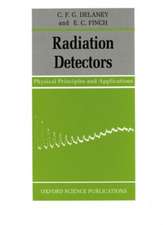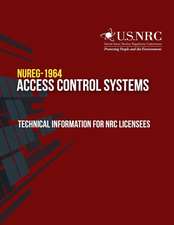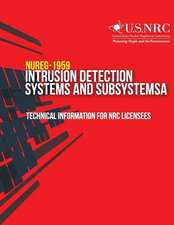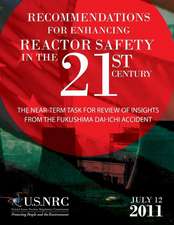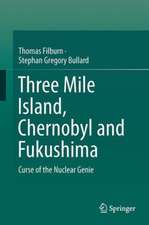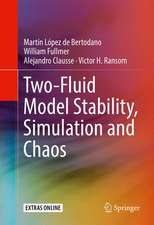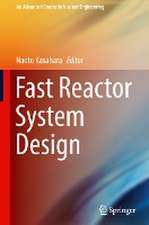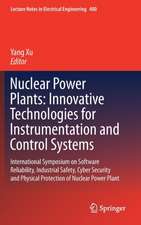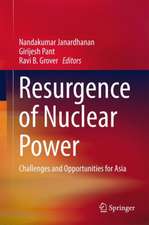Fundamentals of Radiation Materials Science: Metals and Alloys
Autor GARY S. WASen Limba Engleză Hardback – 9 iul 2016
Updated throughout, some major enhancements for the new edition include improved treatment of low- and intermediate-energy elastic collisions and stopping power, expanded sections on molecular dynamics and kinetic Monte Carlo methodologies describing collision cascade evolution, new treatment of the multi-frequency model of diffusion, numerous examples of RIS in austenitic and ferritic-martensitic alloys, expanded treatment of in-cascade defect clustering, cluster evolution, and cluster mobility, new discussion of void behavior near grain boundaries, a new section on ion beam assisted deposition, and reorganization of hardening, creep and fracture of irradiated materials (Chaps 12-14) to provide a smoother and more integrated transition between the topics.
The book also contains two new chapters. Chapter 15 focuses on the fundamentals of corrosion and stress corrosion cracking, covering forms of corrosion, corrosion thermodynamics, corrosion kinetics, polarization theory, passivity, crevice corrosion, and stress corrosion cracking. Chapter 16 extends this treatment and considers the effects of irradiation on corrosion and environmentally assisted corrosion, including the effects of irradiation on water chemistry and the mechanisms of irradiation-induced stress corrosion cracking.
The book maintains the previous style, concepts are developed systematically and quantitatively, supported by worked examples, references for further reading and end-of-chapter problem sets. Aimed primarily at students of materials sciences and nuclear engineering, the book will also provide a valuable resource for academic and industrial research professionals.
Reviews of the first edition:
"…nomenclature, problems and separate bibliography at the end of each chapter allow to the reader to reach a straightforward understanding of the subject, part by part. … this book is very pleasant to read, well documented and can be seen as a very good introduction to the effects of irradiation on matter, or
as a good references compilation for experimented readers." - Pauly Nicolas, Physicalia Magazine, Vol. 30 (1), 2008“The text provides enough fundamental material to explain the science and theory behind radiation effects in solids, but is also written at a high enough level to be useful for professional scientists. Its organization suits a graduate level materials or nuclear science course… the text was written by a noted expert and active researcher in the field of radiation effects in metals, the selection and organization of the material is excellent… may well become a necessary reference for graduate students and researchers in radiation materials science.” - L.M. Dougherty, 07/11/2008, JOM, the Member Journal of The Minerals, Metals and Materials Society.
| Toate formatele și edițiile | Preț | Express |
|---|---|---|
| Paperback (1) | 509.88 lei 38-44 zile | |
| Springer – 30 mai 2018 | 509.88 lei 38-44 zile | |
| Hardback (1) | 701.51 lei 22-36 zile | +68.01 lei 5-11 zile |
| Springer – 9 iul 2016 | 701.51 lei 22-36 zile | +68.01 lei 5-11 zile |
Preț: 701.51 lei
Preț vechi: 855.50 lei
-18% Nou
Puncte Express: 1052
Preț estimativ în valută:
134.23€ • 140.53$ • 111.07£
134.23€ • 140.53$ • 111.07£
Carte disponibilă
Livrare economică 17-31 martie
Livrare express 28 februarie-06 martie pentru 77.100 lei
Preluare comenzi: 021 569.72.76
Specificații
ISBN-13: 9781493934362
ISBN-10: 1493934368
Pagini: 900
Ilustrații: XXVII, 1002 p. 625 illus., 448 illus. in color.
Dimensiuni: 155 x 235 x 54 mm
Greutate: 1.77 kg
Ediția:2nd ed. 2017
Editura: Springer
Colecția Springer
Locul publicării:New York, NY, United States
ISBN-10: 1493934368
Pagini: 900
Ilustrații: XXVII, 1002 p. 625 illus., 448 illus. in color.
Dimensiuni: 155 x 235 x 54 mm
Greutate: 1.77 kg
Ediția:2nd ed. 2017
Editura: Springer
Colecția Springer
Locul publicării:New York, NY, United States
Public țintă
Academic/professional/technical: Research and professionalCuprins
Part I Radiation Damage.- 1 The Radiation Damage Event.- 2 The Displacement of Atoms.- 3 The Damage Cascade.- 4 Point Defect Formation and Diffusion.- 5 Radiation-Enhanced and Diffusion Defect Reaction Rate Theory.- Part II Physical Effects of Radiation Damage.- 6 Radiation-Induced Segregation.- 7 Dislocation Microstructure.- 8 Irradiation-Induced Voids and Bubbles.- 9 Phase Stability Under Irradiation.- 10 Unique Effects of Ion Irradiation.- 11 Simulation of Neutron Irradiation Effects with Ions.- Part III Mechanical Effects of Radiation Damage.- 12 Irradiation Hardening and Deformation.- 13 Irradiation Creep and Growth.- 14 Fracture and Embrittlement.- 15 Corrosion and Stress Corrosion Cracking Fundamentals.- 16 Effects of Irradiation on Corrosion and Environmentally Assisted Cracking.- Index.
Notă biografică
Professor Gary Was is the Walter J. Weber, Jr. Professor of Sustainable Energy, Environmental and Earth Systems Engineering and holds appointments in Nuclear Engineering and Radiological Sciences, and Materials Science and Engineering at the University of Michigan. He has held positions as Director of the Michigan Memorial Phoenix Energy Institute, Associate Dean of the College of Engineering and Chair of the Nuclear Engineering and Radiological Sciences Department. Professor Was’ research is focused on materials for advanced nuclear energy systems and radiation materials science, including environmental effects on materials, radiation effects, ion beam surface modification of materials and nuclear fuels. His current research includes development of structural materials for the SFR, behavior of fuel in the VHTR, fuel behavior modeling in LWRs, irradiation assisted stress corrosion cracking and irradiation-accelerated corrosion in water reactor environments. He is a Fellowof the Materials Research Society, ASM International, NACE International and the American Nuclear Society. Professor Was has published over 200 technical articles in referred, archival journals, presented over 300 conference papers, delivered 180 invited talks and seminars, and has published a graduate level textbook on Radiation Materials Science. Professor Was received the Presidential Young Investigator award from NSF,
the Champion H. Matthewson Award from TMS, the Outstanding and Special Achievement Awards by the Materials Science and Technology Division of the American Nuclear Society, the Henry Marion Howe Medal from ASM, and the Lee Hsun Award from the Chinese Academy of Sciences.
the Champion H. Matthewson Award from TMS, the Outstanding and Special Achievement Awards by the Materials Science and Technology Division of the American Nuclear Society, the Henry Marion Howe Medal from ASM, and the Lee Hsun Award from the Chinese Academy of Sciences.
Textul de pe ultima copertă
The revised second edition ofthis established text offers readers a significantly expanded introduction tothe effects of radiation on metals and alloys. It describes the variousprocesses that occur when energetic particles strike a solid, inducing changesto the physical and mechanical properties of the material. Specifically itcovers particle interaction with the metals and alloys used in nuclear reactorcores and hence subject to intense radiation fields. It describes the basics ofparticle-atom interaction for a range of particle types, the amount and spatialextent of the resulting radiation damage, the physical effects of irradiationand the changes in mechanical behavior of irradiated metals and alloys.
Updated throughout, some majorenhancements for the new edition include improved treatment of low- andintermediate-energy elastic collisions and stopping power, expanded sections onmolecular dynamics and kinetic Monte Carlo methodologies describing collisioncascade evolution, new treatment of the multi-frequency model of diffusion,numerous examples of RIS in austenitic and ferritic-martensitic alloys,expanded treatment of in-cascade defect clustering, cluster evolution, andcluster mobility, new discussion of void behavior near grain boundaries, a newsection on ion beam assisted deposition, and reorganization of hardening, creepand fracture of irradiated materials (Chaps 12-14) to provide a smoother andmore integrated transition between the topics. The book also contains two newchapters. Chapter 15 focuses on the fundamentals of corrosion and stresscorrosion cracking, covering forms of corrosion, corrosion thermodynamics,corrosion kinetics, polarization theory, passivity, crevice corrosion, andstress corrosion cracking. Chapter 16 extends this treatment and considers theeffects of irradiation on corrosion and environmentally assisted corrosion,including the effects of irradiation on water chemistry and the mechanisms ofirradiation-induced stress corrosion cracking.
The book maintains the previousstyle, concepts are developed systematically and quantitatively, supported byworked examples, references for further reading, end-of-chapter problem setsand an online solutions manual. Aimed primarily and students of materialssciences and nuclear engineering, the book will also provide a valuableresource for academic and industrial research professionals.
Updated throughout, some majorenhancements for the new edition include improved treatment of low- andintermediate-energy elastic collisions and stopping power, expanded sections onmolecular dynamics and kinetic Monte Carlo methodologies describing collisioncascade evolution, new treatment of the multi-frequency model of diffusion,numerous examples of RIS in austenitic and ferritic-martensitic alloys,expanded treatment of in-cascade defect clustering, cluster evolution, andcluster mobility, new discussion of void behavior near grain boundaries, a newsection on ion beam assisted deposition, and reorganization of hardening, creepand fracture of irradiated materials (Chaps 12-14) to provide a smoother andmore integrated transition between the topics. The book also contains two newchapters. Chapter 15 focuses on the fundamentals of corrosion and stresscorrosion cracking, covering forms of corrosion, corrosion thermodynamics,corrosion kinetics, polarization theory, passivity, crevice corrosion, andstress corrosion cracking. Chapter 16 extends this treatment and considers theeffects of irradiation on corrosion and environmentally assisted corrosion,including the effects of irradiation on water chemistry and the mechanisms ofirradiation-induced stress corrosion cracking.
The book maintains the previousstyle, concepts are developed systematically and quantitatively, supported byworked examples, references for further reading, end-of-chapter problem setsand an online solutions manual. Aimed primarily and students of materialssciences and nuclear engineering, the book will also provide a valuableresource for academic and industrial research professionals.
Caracteristici
Expands the treatment of the role of the environment to give more of a background on corrosion Presents newer and more detailed information on environmental effects in radiation materials science Provides a foundation for understanding the theory and mechanisms behind the effects of irradiation on metals and alloys Includes a solution set to the problems at the end of each chapter, as well as electronic supplementary material Includes supplementary material: sn.pub/extras Request lecturer material: sn.pub/lecturer-material

